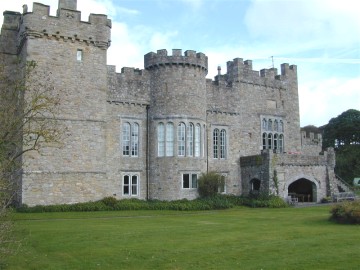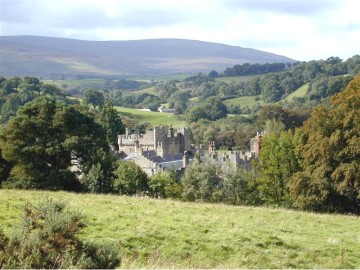

Featherstone
Featherstone is a hamlet of Haltwhistle parish and Featherstone Castle can be found here. This was originally a 12th century tower. A pele tower was added in 1330 and later a 19th century mansion was added. The slaying of Sir Albany Featherstonehaugh in 1530 by a party of Ridleys, a result, it is believed, of a prevailing deadly feud. The location of this incident is still named as Deadman's Haugh, about a mile from the castle, across the river. The castle is currently "a residential centre in the South Tyne valley near Haltwhistle and located in an old castle. For young people and students. Self catering."
The castle is associated with a ghostly bridal party. Baron Featherstonehaugh had arranged for his daughter to marry a relative of his choice, even though the daughter was in love with someone else. The wedding party left for the "traditional hunt" after the wedding, leaving the baron behind to make arrangements for the banquet. When the party failed to return by midnight, the baron began to fear the worst. Sitting alone at the table, he heard horses crossing the drawbridge. The door opened and the party entered. But, they made no sound and passed through furniture. The wedding party had been ambushed and killed. On the anniversary of the wedding, the party can still be seen heading towards the castle.


1868
"FEATHERSTONE, a township in the parish of Haltwhistle, W. division of the ward of Tynedale, county Northumberland, 3 miles S.W. of Haltwhistle, and 10 N. of Alston. It is situated E. of the South Tyne, and is a station on the railway connecting the above towns. Featherstone Castle was built by the Featherstonehaughs, a family resident here from time immemorial. It is now the property of the Wallace family, having been confiscated by the Parliamentarians, who sold it to the earls of Carlisle. The mansion has recently been repaired and enlarged. Divine service is performed in the castle chapel, which, on Sundays, is open to those living in the vicinity. The Earl of Carlisle is lord of the manor."
1910
Featherstone township, embracing the small hamlets of Kellah, Rowfoot and Redpath, is pleasantly seated near the South Tyne and has a station on the Alston branch
Railway 3 miles south west from Haltwhistle
Featherstone Castle, the residence of James Hope-Wallace Esq. J.P. Seated in a picturesque valley near the South Tyne, and surrounded by beautifully wooded scenery, consists in part ancient Border tower, built in 1290 by Thomas de Featherstone a member of a family once very powerful in these parts, and who first occupied a strong castle higher up among the hills, but afterwards removed to the site of the present edifice, on a level called the " Haugh," when the name changed to that of Featherstonhaugh.
Sir Timothy Featherstonhaugh, a devoted Royalist, supported Charles II. at the battle of Worcester, 3rd September, 1651, and thereby lost his estates in 1775 the castle was sold to James Wallace esq. of Carleton Hall, Cumb. attorney-general in 1780, and father of Thomas, 1st Baron Wallace, of Knarsdale, a title which became extinct on his death, 23rd February, 1844 ; the modern portion of the mansion; built in the castellated style, includes a gallery. 60 feet in length; in the grounds is a mausoleum in which are buried Lord Wallace and Lady Jane (Hope) Viscountess Melville, and daughter of John 2nd Earl of Hopetown, who died 9th June, 1829 : in the mausoleum are memorial tablets to these and to James Wallace esq. of Carleton Hall, Cumb. died at Exeter. Nov. 10th, 1783; Elizabeth, his wife, died 18th April, 1811, and Elizabeth, their daughter, died at Clifton, near Bristol, in 1792.
A ballad, composed by Surtees on the death of Sir Albany Featherstonhaugh who was killed in a border feud at Greensilhaugh, about a mile from the castle, on the 24th October, 1530, by his neighbours, Blenkinsopp of Blenkinsopp and Ridley of Unthank, was included by Sir Walter Scott in the " Border Minstrelsy."
Divine Service is conducted in the school room every alternate Sunday, at 2.30 p.m. and every Sunday evening at 6.30. The coal in Featherstone Royalty is worked by the Coanwood Coal Co.
Henry Turner, butler of Featherstone Castle, left the sum of £100 for the poor of Featherstone Castle there being no poor, a scheme was formed by the Charity Commissioners, dated 10th March 1868, whereby the interest, amounting to £3 8s. 4d. should be applied to educational purposes, and this sum is now assigned by the managers of the school the charity now (1910) consists of £124 4s. 3d. invested in 3 percent. Consols. The Earl of Carlisle is lord of the manor, and James Hope-Wallace esq. is the principal landowner. The area of the township is 2,954 acres of land and 50 of water; rateable value, £3,117; the population in 1901 was 267.
